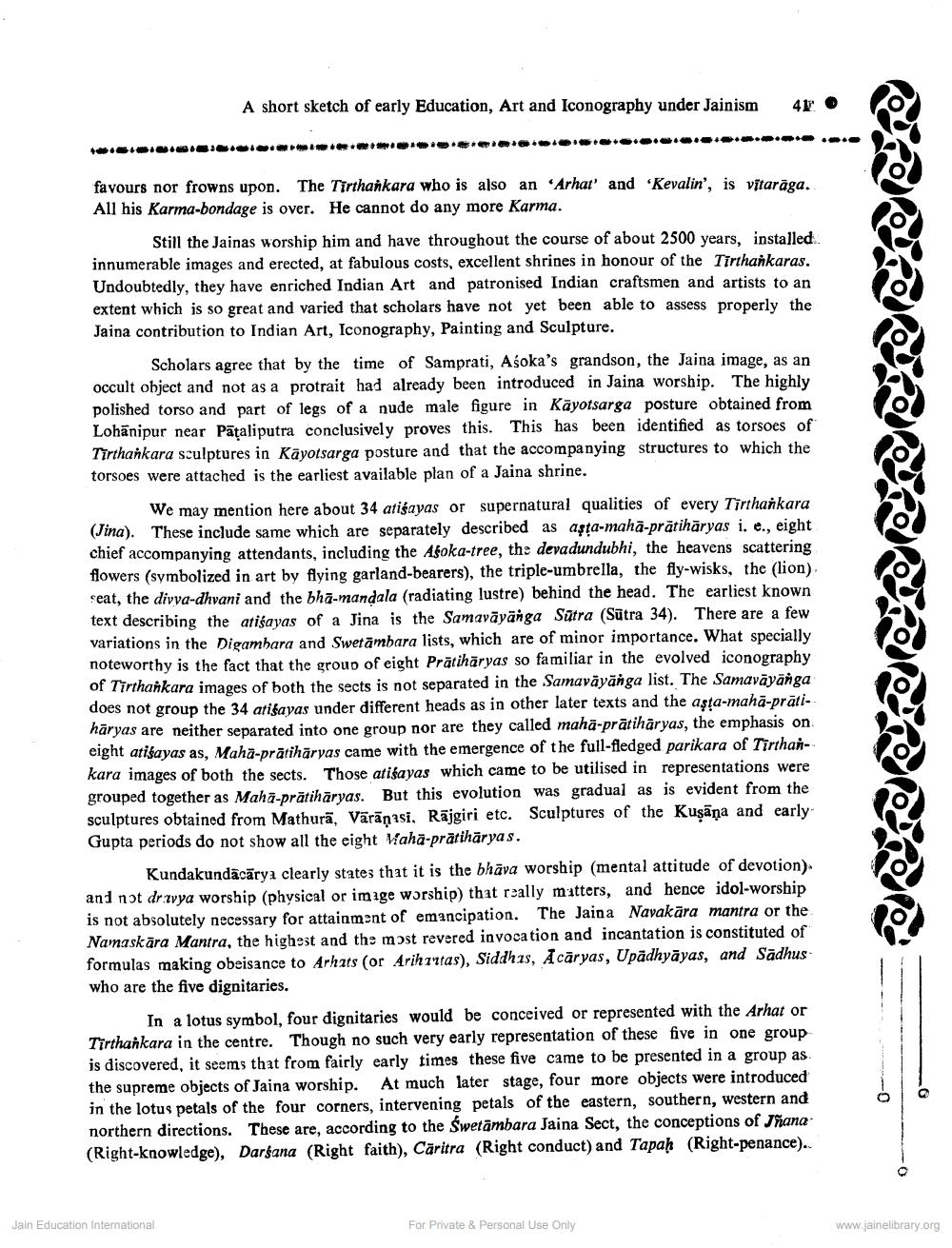________________
A short sketch of early Education, Art and Iconography under Jainism
41
favours nor frowns upon. The Tirthankara who is also an Arhar' and 'Kevalin', is vītaräga. All his Karma-bondage is over. He cannot do any more Karma.
Still the Jainas worship him and have throughout the course of about 2500 years, installed innumerable images and erected, at fabulous costs, excellent shrines in honour of the Tirthankaras. Undoubtedly, they have enriched Indian Art and patronised Indian craftsmen and artists to an extent which is so great and varied that scholars have not yet been able to assess properly the Jaina contribution to Indian Art, Iconography, Painting and Sculpture.
Scholars agree that by the time of Samprati, Asoka's grandson, the Jaina image, as an occult object and not as a protrait had already been introduced in Jaina worship. The highly polished torso and part of legs of a nude male figure in Käyotsarga posture obtained from Lohänipur near Pataliputra conclusively proves this. This has been identified as torsoes of Tirthankara sculptures in Kāyotsarga posture and that the accompanying structures to which the torsoes were attached is the earliest available plan of a Jaina shrine.
We may mention here about 34 atisayas or supernatural qualities of every Tirthankara (Jina). These include same which are separately described as aşta-mahā-prātihāryas i. e., eight chief accompanying attendants, including the Asoka-tree, the devadundubhi, the heavens scattering flowers (symbolized in art by flying garland-bearers), the triple-umbrella, the fly-wisks, the (lion) seat, the divya-dhvani and the bhā-mandala (radiating lustre) behind the head. The earliest known text describing the atisayas of a Jina is the Samavāyānga Sūtra (Sūtra 34). There are a few variations in the Digamhara and Swetāmbara lists, which are of minor importance. What specially noteworthy is the fact that the group of eight Prātihāryas so familiar in the evolved iconography of Tirthankara images of both the sects is not separated in the Samaväyänga list. The Samavāyanga does not group the 34 atibayas under different heads as in other later texts and the asta-mahā-prātihāryas are neither separated into one group nor are they called mahā-prātihāryas, the emphasis on eight atisayas as, Mahā-prātihāryas came with the emergence of the full-fledged parikara of Tirthankara images of both the sects. Those atifayas which came to be utilised in representations were grouped together as Maha-prätihāryas. But this evolution was gradual as is evident from the sculptures obtained from Mathurā, Vārāṇasi, Rājgiri etc. Sculptures of the Kuşāņa and earlyGupta periods do not show all the eight Mahā-prātihāryas.
Kundakundācārya clearly states that it is the bhāva worship (mental attitude of devotion) and not dr.zvya worship (physical or image worship) that really matters, and hence idol-worship is not absolutely necessary for attainment of emancipation. The Jaina Navakāra mantra or the Namaskāra Mantra, the highest and the most revered invocation and incantation is constituted of formulas making obeisance to Arhats (or Arihitas), Siddhas, A cāryas, Upadhyāyas, and Sadhuswho are the five dignitaries.
In a lotus symbol, four dignitaries would be conceived or represented with the Arhat or Tirthankara in the centre. Though no such very early representation of these five in one group is discovered, it seems that from fairly early times these five came to be presented in a group as the supreme objects of Jaina worship. At much later stage, four more objects were introduced in the lotus petals of the four corners, intervening petals of the eastern, southern, western and northern directions. These are, according to the Swetāmbara Jaina Sect, the conceptions of Jñana (Right-knowledge), Darsana (Right faith), Caritra (Right conduct) and Tapah (Right-penance)..
Jain Education International
For Private & Personal Use Only
www.jainelibrary.org




